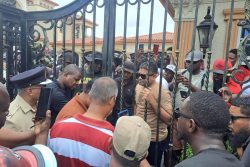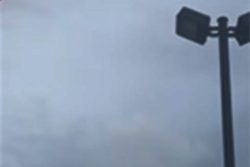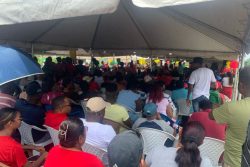On August 8 this year, a cane farmer died in an accident on the Zorg-en-Vlygt Public Road in Essequibo; on August 12, a mother died in an accident involving a minibus and a car on the Lima Public Road and the two drivers died subsequently; on August 13 a six-year-old boy was killed by a minibus which was allegedly speeding near the Plaza bridge in Georgetown; on the same day a labourer riding his bicycle was killed by a car which was allegedly speeding on the No 53 road; on August 20, a man died following a crash involving two vehicles at Land of Canaan; on August 25 a motor cyclist was killed in an accident with a car at Conversation Tree; on August 26 a man was killed in a hit-and-run on the No 10 road, West Coast Berbice; on August 26 too, on the Bath Public Road a man was killed by an out-of-control truck which was allegedly speeding; on August 27 a former soldier died after being hit first by a car, and then being run over by a lorry when about to cross the road; again on August 27 a cyclist was killed on the Good Hope road in a hit-and-run; and on August 28 a man was killed in an accident at Saffon Street, La Penitence.
Coming into September, on the 5th of that month a cyclist was killed at Mon Repos by a pick-up, the driver of which was allegedly drunk; on September 6 a truck driver died in a collision on the Linden-Soesdyke Highway at Kairuni; on September 7, a child and former Police Commissioner Henry Greene who was allegedly speeding in his SUV were killed in an accident involving three vehicles; on September 12 a motor cyclist died on the Mahaicony Public Road after overtaking a car on the inside that then turned into a side street; on September 13 a motor cyclist who was drag racing was killed on the East Canje Public Road; on September 15 a 71-year-old pedestrian was killed crossing the road at Industry; on September 16 a 76-year-old died in a three-way smash-up near Atlanticville; on September 22 three died in a vehicle which was overtaking on the East Bank and hit a sand truck; and on September 23 a pedestrian was killed by a truck on the Chateau Margot embankment road.
In the almost eight weeks from August 1 to September 23 as recorded in our newspaper 26 people were killed on our roads in 21 fatal accidents (there may conceivably be one or two others as well which we did not cover and are therefore not included above). It is the equivalent to someone being killed on our roads every two days. This, of course, does not take into account those accidents where persons were badly injured, but no one died, so if one were to take serious accidents as a whole, therefore, obviously the figure in that respect would be considerably higher.
On August 14 the police issued a statement saying that at the end of July road fatalities were down by 30% compared to the same period last year. If on the basis of their press release, they were entertaining any hopes that the rate of road fatalities was decreasing, that optimism would clearly have been misplaced. Certainly for the past two months the situation is more-or-less back to what it was in the first half of last year, although no one knows if it will continue on this trajectory to the end of 2012.
The months up to the end of July, the police said, recorded a total of 51 fatalities and 49 fatal accidents. Speeding, they went on, continued to be a major contributing factor to these accidents, accounting for 35 of the total. Speeding was also the major factor in the instances cited above, although there were some of them where it was alleged that alcohol too played a role. Nowadays the public does not get the detailed breakdowns from the police hierarchy that used to be forthcoming, so we do not know, for example, which are Guyana’s most dangerous roads. Some years ago it was the East Bank road and the East Coast corridor, and one has the impression that this might not have changed.
What one would like to see are the accident figures over the last ten years, say, along with the increase in the number of vehicles – which has been tremendous – on the roads, so one can spot trends. While the number of roads has remained relatively stable except in the new housing schemes which do not account for the majority of accidents anyway, the character of some of our roads has changed, as on the East Bank, for instance. It would be good if the police could tell the public whether there are more accidents on our highways, for example, than on the narrower roads, and whether the four-lane or multi-lane carriageways invite speeding.
No matter what the statistics, everyone has a fairly good general idea of what the problem is: the law is simply not being enforced.
Every day the average road user can give examples of breaches of the traffic laws that they have witnessed, some of them quite egregious, and yet there will be no police around to detain anybody. At night especially, anything goes; barring some reception or event, when the police will be seen directing traffic, there are rarely members of Guyana’s finest to be espied on the streets after 7pm. It is no secret that the police force is under strength, and that will undoubtedly apply to the Traffic Department as much as to any other division of the GPF, so perhaps a part of the failure to enforce the traffic code might be laid at the door of a manpower problem.
However, it is certainly not the whole explanation, since the situation is complicated by the culture of the ‘raise’, which the public perceives as being particularly prevalent in the traffic section. It is also widely believed that some drivers have ‘bought’ their licences, and have not attended the lectures the police give on the highway code, let alone undergone a practical test. One should add to this the culture of the ‘big ones’, who it is generally believed apply pressure and are extended special treatment or favours when one of their friends or relatives is involved in an accident. Even if charges are brought, it is hardly unknown for files to mysteriously disappear. Those of them who can, of course, simply escape abroad. Unless the government and the senior echelons of the force can come to grips with corruption in the GPF, then the rule of law will continue to be undermined, and by extension people will continue to die on our roads.
That said, however, one cannot help but wonder whether even if the above did not hold, the department as presently constituted is really geared to cope with current conditions. The traffic police are certainly a lot more mobile than they used to be, but that does not appear to have made much impact on the accident rate in and of itself. The Ministry of Home Affairs has installed CCTV cameras all over the city, mainly at intersections where there are traffic lights, but no one is really clear about what their true purpose is. When they were first introduced there was some vague talk about crime prevention and detecting traffic offences, but if there have been cases brought to court where CCTV footage has been produced in evidence, they have not been given any publicity. Many road users have witnessed drivers jumping the traffic lights even when there are cameras in operation, but still no consequences seem to follow.
Of course, these things depend on alert monitors, who in this instance we are told operate from the eyesore cluttering the grounds of Castellani House. Whether it is they are not monitoring the live feed, or drivers who jump the traffic lights are not who they are looking for, there seems to be little effect on the accident rate. There are CCTV cameras installed along motorways in many developed countries which measure vehicle speed and also record the offender’s number, but they are expensive to run, and one doesn’t see the government making that kind of investment in the near future. The GPF did acquire radar guns at one point, but they seem to have gone the way of much equipment here: they no longer function.
There are ancillary things which need attention, such as signage, road markings indicating lanes on the bigger thoroughfares among other things, and above all else, street lights, which are not likely to materialize in a hurry. If farmers were less irresponsible about letting their animals roam, illegal and irresponsible parking came to an end, and parents ceased sending younger children onto busy roads on errands, that too would help in specific instances. But in the end, even if those things were put right, to make a major dent in the figures, it would still come down to systematic enforcement of the law without fear or favour.
When the police force, therefore, informs the public that it is looking at the most meaningful deployment of its limited resources on roads which have the highest incidence of accidents; when the government decides to import the best kind of equipment in a mission to restore order on the roads; when both take measures to deal with endemic corruption in the GPF; and when there is a genuine commitment on the part of the police to systematically enforce the traffic code, particularly in relation to speeding, then maybe there will be some hope of bringing down the accident rate.







